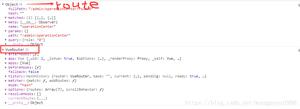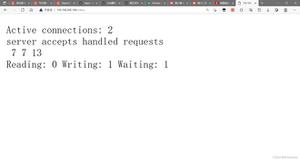详解angularJs模块ui-router之状态嵌套和视图嵌套
状态嵌套的方法
状态可以相互嵌套。有三个嵌套的方法:
- 使用“点标记法”,例如:.state('contacts.list', {})
- 使用parent属性,指定一个父状态的名称字符串,例如:parent: 'contacts'
- 使用parent属性,指定一个父状态对象,例如:parent: contacts(contacts 是一个状态对象)
点标记法
在$stateProvider中可以使用点语法来表示层次结构,下面,contacts.list是contacts的子状态。
$stateProvider
.state('contacts', {})
.state('contacts.list', {});
使用parent属性,指定一个父状态的名称字符串
$stateProvider
.state('contacts', {})
.state('list', {
parent: 'contacts'
});
基于对象的状态
如果你不喜欢使用基于字符串的状态,您还可以使用基于对象的状态。name属性将在状态对象内部设置,在所有的子状态对象中设置parent属性为父状态对象,像下面这样:
var contacts = {
name: 'contacts', //mandatory
templateUrl: 'contacts.html'
}
var contactsList = {
name: 'list', //mandatory
parent: contacts, //mandatory
templateUrl: 'contacts.list.html'
}
$stateProvider
.state(contacts)
.state(contactsList)
$state.transitionTo(states.contacts);在方法调用和属性比较时可以直接引用状态对象:
$state.current === states.contacts;
$state.includes(states.contacts)
注册状态的顺序
可以以任何顺序和跨模块注册状态,也可以在父状态存在之前注册子状态。一旦父状态被注册,将触发自动排序,然后注册子状态。
状态命名
状态不允许重名,当使用“点标记法”,parent属性被推测出来,但这并不会改变状态的名字;当不使用“点标记法”时,parent属性必须明确指定,但你仍然不能让任何两个状态有相同的名称,例如你不能有两个不同的状态命名为”edit”,即使他们有不同的父状态。
嵌套状态和视图
当应用程序在一个特定的状态 - 当一个状态是活动状态时 - 其所有的父状态都将成为活跃状态。下面例子中,当”contacts.list”是活跃状态时,”contacts”也将隐性成为活跃状态,因为他是”contacts.list”的父状态。
子状态将把其对应的模板加载到父状态对应模板的ui-view中。
$stateProvider
.state('contacts', {
templateUrl: 'contacts.html',
controller: function($scope){
$scope.contacts = [{ name: 'Alice' }, { name: 'Bob' }];
}
})
.state('contacts.list', {
templateUrl: 'contacts.list.html'
});
function MainCtrl($state){
$state.transitionTo('contacts.list');
}
<!-- index.html -->
<body ng-controller="MainCtrl">
<div ui-view></div>
</body>
<!-- contacts.html -->
<h1>My Contacts</h1>
<div ui-view></div>
<!-- contacts.list.html -->
<ul>
<li ng-repeat="contact in contacts">
<a>{{contact.name}}</a>
</li>
</ul>
子状态将从父状态继承哪些属性?
子状态将从父母继承以下属性:
- 通过解决器解决的依赖注入项
- 自定义的data属性
除了这些,没有其他属性继承下来(比如controllers、templates和url等)
继承解决的依赖项
版本 v0.2.0 的新特性
子状态将从父状态继承通过解决器解决的依赖注入项,并且可以重写(overwrite)依赖项,可以将解决依赖项注入子状态的控制器和解决函数中。
$stateProvider.state('parent', {
resolve:{
resA: function(){
return {'value': 'A'};
}
},
controller: function($scope, resA){
$scope.resA = resA.value;
}
})
.state('parent.child', {
resolve:{
// 将父状态的解决依赖项注入到子状态的解决函数中
resB: function(resA){
return {'value': resA.value + 'B'};
}
},
// 将父状态的解决依赖项注入到子状态的控制器中
controller: function($scope, resA, resB){
$scope.resA2 = resA.value;
$scope.resB = resB.value;
}
继承自定义data属性值
子状态将从父状态继承自定义data属性值,并且可以重写(overwrite)data属性值
$stateProvider.state('parent', {
data:{
customData1: "Hello",
customData2: "World!"
}
})
.state('parent.child', {
data:{
// customData1 inherited from 'parent'
// 覆盖了 customData2 的值
customData2: "UI-Router!"
}
});
$rootScope.$on('$stateChangeStart', function(event, toState){
var greeting = toState.data.customData1 + " " + toState.data.customData2;
console.log(greeting);
// 'parent'被激活时,输出 "Hello World!"
// 'parent.child'被激活时,输出 "Hello UI-Router!"
})
Abstract States 抽象状态
一个抽象的状态可以有子状态但不能显式激活,它将被隐性激活当其子状态被激活时。
下面是一些你将可能会使用到抽象状态的示例:
- 为所有子状态预提供一个基url
- 在父状态中设置template属性,子状态对应的模板将插入到父状态模板中的ui-view(s)中
- 通过resolve属性,为所有子状态提供解决依赖项
- 通过data属性,为所有子状态或者事件监听函数提供自定义数据
- 运行onEnter或onExit函数,这些函数可能在以某种方式修改应用程序。
- 上面场景的任意组合
请记住:抽象的状态模板仍然需要<ui-view/>,来让自己的子状态模板插入其中。因此,如果您使用抽象状态只是为了预提供基url、提供解决依赖项或者自定义data、运行onEnter/Exit函数,你任然需要设置template: "<ui-view/>"。
抽象状态使用示例:
为子状态提供一个基url,子状态的url是相对父状态的
$stateProvider
.state('contacts', {
abstract: true,
url: '/contacts',
// Note: abstract still needs a ui-view for its children to populate.
// You can simply add it inline here.
template: '<ui-view/>'
})
.state('contacts.list', {
// url will become '/contacts/list'
url: '/list'
//...more
})
.state('contacts.detail', {
// url will become '/contacts/detail'
url: '/detail',
//...more
})
将子状态模板插入到父状态指定的ui-view中
$stateProvider
.state('contacts', {
abstract: true,
templateURL: 'contacts.html'
)
.state('contacts.list', {
// loaded into ui-view of parent's template
templateUrl: 'contacts.list.html'
})
.state('contacts.detail', {
// loaded into ui-view of parent's template
templateUrl: 'contacts.detail.html'
})
<!-- contacts.html -->
<h1>Contacts Page</h1>
<div ui-view></div>
完整示例
$stateProvider
.state('contacts', {
abstract: true,
url: '/contacts',
templateUrl: 'contacts.html',
controller: function($scope){
$scope.contacts = [{ id:0, name: "Alice" }, { id:1, name: "Bob" }];
}
})
.state('contacts.list', {
url: '/list',
templateUrl: 'contacts.list.html'
})
.state('contacts.detail', {
url: '/:id',
templateUrl: 'contacts.detail.html',
controller: function($scope, $stateParams){
$scope.person = $scope.contacts[$stateParams.id];
}
})
<!-- contacts.html -->
<h1>Contacts Page</h1>
<div ui-view></div>
<!-- contacts.list.html -->
<ul>
<li ng-repeat="person in contacts">
<a ng-href="#/contacts/{{person.id}}" rel="external nofollow" >{{person.name}}</a>
</li>
</ul>
<!-- contacts.detail.html -->
<h2>{{ person.name }}</h2>
以上是 详解angularJs模块ui-router之状态嵌套和视图嵌套 的全部内容, 来源链接: utcz.com/z/337078.html








